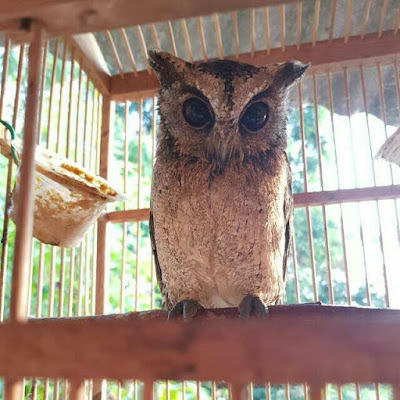(Taken by my brother, 2018)
One day, I found a baby owl in my home. It's in a cage. My father told me he found it in our field. Honestly, I didn't like to take care of the owl in our home. I think nature can do it best. But my father explained to me that It fell down from coconut tree, and almost stepped on. So my father decided to bring it home.
Unfortunately, I didn't know anything about owls. All I knew, the owl was just Buek (Sundanese). It's the first time I saw an owl on my own self directly, not just pictures on TV or the Internet. Then I tried to look for information about this owl. Finally, I knew It's Celepuk Reban (Otus lempiji). I didn't have any determination key of the bird. But I found a helpful page that gives information about owl species with pictures and characteristics each owl.
I compared the owl that my father found with an owl that page explained. And the conclusion, the owl was Celepuk Reban (Otus lempiji). For me who didn't know anything about owls, it's really hard to find the right name of this owl. In the same genus, if we just see the picture, they look similar. But Fadli (2014) on his blog, explained that Sunda Scops Owl-Otus lempiji nested on coconut midrib. So the data was suitable for this owl.
Actually, I didn't determine this owl in baby phase because in baby phase the colour of this owl still grey and I guess it would be changing and maybe the other morphology too. I wonder how big it will be. I just thought like that and it's true, the colour change but the size did not change significantly, maybe because this owl included small owl. Finally, according to this data, maybe i can treat better this owl. At least the proper and preferred food for the owl. So it can be a happy and healthy owl.
Here the owl description.
Classification
Kingdom: Animalia
Here the owl description.
Classification
Kingdom: Animalia
Phylum : Chordata
Class : Aves
Order : Strigiformes
Family : Strigidae
Genus : Otus
Species : Otus lempiji Horsfield, 1821
Class : Aves
Order : Strigiformes
Family : Strigidae
Genus : Otus
Species : Otus lempiji Horsfield, 1821
Status
References
- Least Concern
Distribution
- Java, Bali, Sumatra, Borneo, Malay Peninsula (Lewis, 2015)
Diet
Mostly insect
References
- HBW
- The IUCN Red List
- Lewis, Deane, 2015. Sunda Scops Owl (Otus Lempiji).

Comments
Post a Comment